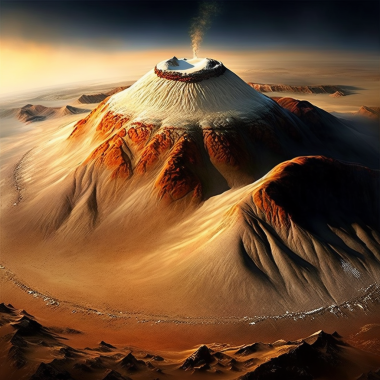
Introduction
Mountains are some of the most fascinating and awe-inspiring natural features on our planet. They not only shape the landscapes and environments around them but also hold clues to the geological and environmental history of our planet. While we are familiar with some of the tallest mountains on Earth, such as Mount Everest and K2, there are mountains on other planets and moons in our solar system that are even more impressive. In this article, we will explore the tallest mountain in the solar system, the Olympus Mons on Mars, and its significance in planetary science and exploration.
Location and Height The Olympus Mons is located on the planet Mars and is the largest volcanic mountain in the solar system. It is a shield volcano, which means that it has a broad, gentle slope with a caldera at the summit. The mountain is located near the Martian equator in the Tharsis volcanic plateau and covers an area roughly equivalent to the size of the state of Arizona. The Olympus Mons is over 13 miles (22 km) high, which is three times the height of Mount Everest, making it the tallest mountain in the solar system.
Formation of Olympus Mons The Olympus Mons is thought to have formed from a hotspot in the Martian mantle, which caused a long-lasting volcanic eruption. The lava flows from the eruption accumulated over time, forming the broad shield-shaped mountain we see today. The mountain is believed to be relatively young, geologically speaking, and estimates suggest that it may be around 100 million years old, which is much younger than some of Earth's mountains.
Comparison with Other Planetary Mountains The Olympus Mons is not the only impressive mountain in our solar system. Other notable mountains include the central peak of the Rheasilvia crater on the asteroid Vesta, the Maxwell Montes on Venus, and the Boösaule Montes on Jupiter's moon Io. However, the Olympus Mons stands out as the largest and tallest of them all.

Geological Features of Olympus Mons
Caldera and Magma Chamber At the summit of the Olympus Mons lies a caldera, a large circular depression that is thought to have formed when the volcano collapsed after the magma chamber emptied. The caldera has a diameter of around 50 miles (80 km) and a depth of around 1.2 miles (2 km). The magma chamber that feeds the volcano is thought to be several miles beneath the surface of Mars.
Lava Flows and Surface Features The Olympus Mons has a very gentle slope, which makes it different from many other volcanoes on Earth. Its slopes have lava channels and tubes, and the lava flows have created intricate patterns on the surface of the mountain. The surface of the mountain is also covered with impact craters, which are evidence of the mountain's age and the history of the planet.
Comparison with Earth's Shield Volcanoes The Olympus Mons is a shield volcano, which is a type of volcano that is also found on Earth. Shield volcanoes are known for their broad, gentle slopes, and they are formed by the accumulation of successive lava flows. Examples of shield volcanoes on Earth include Mauna Loa in Hawaii and Erta Ale in Ethiopia.
Significance of Olympus Mons
Exploration and Research on Mars The Olympus Mons is an important location for scientific exploration on Mars. NASA's Mars rovers have visited the area around the volcano, and scientists are interested in studying the geological features of the mountain and the surrounding area. Studying the Olympus Mons can also provide insights into the geological history and volcanic activity of Mars.
Impacts on Martian Atmosphere and Climate The Olympus Mons is so massive that it has an impact on the Martian atmosphere and climate. The mountain's height causes atmospheric pressure differences, which can create strong winds that shape the surrounding landscape. The mountain also affects the distribution of atmospheric dust and may have played a role in the formation of the Martian polar ice caps.
Potential for Future Human Settlement The exploration and study of the Olympus Mons also raise the possibility of future human settlement on Mars. The mountain's gentle slopes and volcanic activity could provide a source of water, minerals, and energy for future colonists.
Conclusion
Olympus Mons on Mars is a remarkable geological feature, towering three times higher than the tallest mountain on Earth. With its unique shield volcano formation and fascinating geological history, the mountain holds immense potential for scientific study and exploration. Further research and missions to study this Martian mountain can provide valuable insights into the formation and evolution of planets in our solar system
